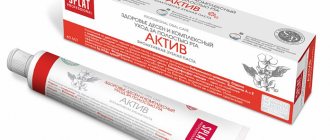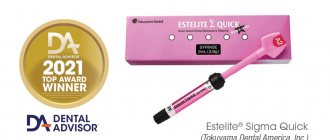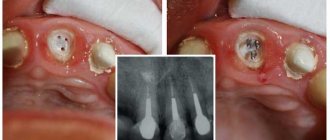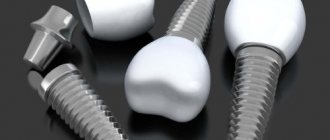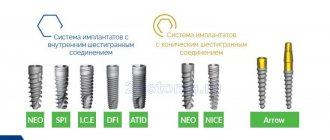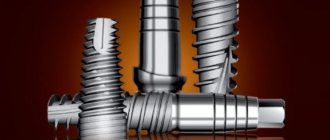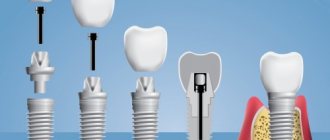Model range Disadvantages Indications and contraindications Installation steps Prices Comparison with other brands How to choose a clinic?
When back in 1974, a small Swiss company released its first implants, no one could have thought that this was the first step towards world leadership in the field of implantology and restorative dentistry. Today, Swiss Straumann implants are known throughout the world. They are preferred by implantologists from all continents, because the products of this brand combine high quality, a scientific approach and a full set of related materials. Strauman implants don’t just restore your smile—they restore your self-confidence.
All the company's products are based on scientific developments. Therefore, the company has many technological breakthroughs in the field of dental restoration and implantation.
When is prosthetics indicated?
Installing a crown on a tooth is a necessary procedure in situations where the patient:
- the tooth is destroyed as a result of injury, abrasion of enamel or carious lesions,
- extensions, fillings and other treatment methods are not possible,
- the root remained intact.
Some defects, including discoloration of the enamel, lead to an unaesthetic appearance of the entire dentition. The crown will protect the tooth walls from external impacts. Tooth mobility is caused by various periodontal pathologies. In this case, the use of temporary crowns is considered, which make it possible to strengthen the teeth and make them more stable. Crowns are also placed on healthy teeth, which act as support for defects associated with the installation of bridges and dentures.
Advantages
Concrete cements from Swiss manufacturers have a number of advantages that distinguish them from analogue models:
- long warranty periods for the product – the quality of the prostheses is such that, if used correctly, they can be used for almost a lifetime;
- almost complete absence of rejection – an exception of only 2%. This includes individual intolerance to medical titanium alloy, which is extremely rare in humans;
- the ability to select a model for the anatomical characteristics of each patient;
- minimum postoperative complications - ensured by the reliability, hypoallergenic design, and extreme technical simplicity of the device;
- the engraftment process takes no more than a month , which shortens the full period of restoration measures;
- deliveries in containers that maintain the optimal humidity level required for this type of product;
The technology of production and implantation of the structure is carried out in a gentle mode of grinding down the hard tissue of the jaw, minimally disturbing its integrity and allowing this fragment of the jaw row to maintain its functionality.
Types of Dental Crowns
There are different options depending on the raw material from which they are made. Each of them has its pros and cons.
Metal
Classic dentures in dentistry. Currently, inexpensive alloys made from medical steel, which is not subject to oxidation and is a durable, wear-resistant material, are often used for the manufacture of orthopedic structures. Disadvantages include an unaesthetic appearance and the risk of allergic reactions. Such dentures are installed on chewing teeth, which are not visible when a person talks or smiles.
Metal ceramics
Such crowns are durable and aesthetically attractive. In addition, their cost is significantly lower than all-ceramic analogues. The disadvantages of this type of prosthetics is that it is impossible to achieve the effect of transparency of the cutting edges in the prosthetic group of the anterior teeth.
Ceramics
The most attractive and expensive option. All-ceramic dentures are made from porcelain processed on a special milling machine. They are very similar to natural teeth. However, ceramics are fragile and cannot withstand significant chewing loads. Therefore, dentures made from it are used to restore front teeth.
Zirconium dioxide
It is not inferior in strength to natural tooth enamel. The material is suitable for the manufacture of solid bridges. The shade of zirconium dioxide can be matched exactly to the color of the patient’s natural teeth. The crowns are completely biologically compatible and safe for human health. They are suitable for patients with metal allergies.
Glass ceramics e.max
The most modern denture technology. The structure of the material is closest to tooth enamel. Externally, crowns are indistinguishable from natural teeth. Glass ceramics are biologically inert and hypoallergenic, while they are impervious to dyes and odors.
Straumann implant models
Straumann in Switzerland is continuously working to expand its product range to meet individual patient needs. In collaboration with the International Team for Implantology (ITI), new implantation models and technologies are being developed. Currently, the brand offers several options that differ in design and purpose. All models are united by innovative technologies:
- Bone Control Design
is a development that preserves the volume of soft tissues and the alveolar ridge. - Roxolid
is a titanium-zirconium alloy that is ideal for rapid osseointegration. This alloy is superior to titanium in its strength. Great for small sizes. Helps preserve bone tissue. Products made from this alloy have a lifetime warranty. - synOsta
is a connection that prevents movement of the abutment and ensures its precise fit. Makes it possible to try on, rearrange abutments, and take an impression if one is missing.
How is a crown placed on a tooth?
The procedure takes quite a long time and consists of several stages.
Preparation. At this stage, the doctor draws up a treatment plan, which will depend on the complexity of the particular case, prescribes an x-ray examination and discusses with the patient how the crowns will be installed.
Preliminary treatment may require the removal of teeth if they cannot be restored. A bridge prosthesis involves the use of fixation of several supporting teeth, and one of the points of the plan may be the process of clarifying their number. After this, the cost of installing crowns on the teeth is calculated, and the time frame for manufacturing the prosthetic lock and adaptation to the patient’s oral cavity is determined. After all the preparatory stages before prosthetics, the patient is invited to an orthopedic dentist to treat the supporting teeth and make an impression.
Removal of damaged tissue is carried out using local anesthesia. This also applies to tooth depositing, since during preparation the bur may touch the gums, which may cause discomfort. The condition of the tooth tissue is assessed taking into account the thickness of the crown being installed. Grinding results in the fact that only a stump remains, on which the prosthesis will later be installed.
Making a crown. The doctor takes impressions after preparing all the teeth that will be fixed with single crowns or bridges. Additionally, a 3-dimensional model is created using endoscopic equipment. Using impressions and scan data, dental technicians in the laboratory cast plaster models that are used directly to make the crowns.
Dentures can be made from various materials according to the patient's choice. If the process of producing crowns takes a long time, the patient is provided with plastic structures during this period. This approach not only helps maintain the aesthetics of your smile, but also protects already treated teeth.
Crown fitting. Performed to determine the accuracy of the shape and color of dentures. If the crown fits perfectly, its base is covered with a special ceramic mass. The fitting process can take a long time. At the preparatory stage, the patient will have to visit the dentist at least 2 times. The length of time spent in the doctor's office depends on the condition of the patient's denture. Subsequent production of the prosthesis in the laboratory may take several weeks. Installation of the prosthesis using temporary cement can take about a month.
Installing a crown on a tooth. If the prosthesis is ready, the structure is installed using special cement. Initially, a temporary composition is applied, which allows you to safely control the position of the prosthesis and the reaction of neighboring teeth. If the patient does not experience discomfort, permanent crowns are installed. The choice of method depends on the degree of tooth decay.
Reviews
The Straumann implantation system is known all over the world and is very popular. Yes, the price of the components is on average 5–15% higher than other analogues, but their quality is confirmed not only by certificates, but also by reviews from grateful patients.
You can share your own experience of using the Straumann system by leaving a comment on this article.
The step-by-step procedure for installing Straumann implants is captured in the following video:
If you find an error, please select a piece of text and press Ctrl+Enter.
Tags Straumann implants
Did you like the article? stay tuned
Previous article
Dental hyperesthesia: symptoms, types, therapy
Next article
Tetracycline teeth: signs and treatment of the disease
Contraindications for prosthetics
In some cases, installation is impossible due to concomitant diseases. Local contraindications are:
- the presence of foci of inflammation in the oral cavity;
- insufficient hygiene;
- bleeding gums.
The list of general contraindications includes:
- pathologies limiting surgical intervention;
- allergic reactions to anesthetics;
- chronic diseases of the heart and blood vessels;
- diabetes;
- oncological diseases in the stage of decompensation;
- bleeding disorders;
- mental pathologies;
- exhaustion of the body after long-term drug or chemotherapy.
In addition, it is recommended to postpone prosthetics during pregnancy and lactation.
Prices
The average cost of products is as follows:
| Model names | Product cost in rubles | Turnkey installation in rubles |
| Standard | 14 000–22 000 | 35 000 |
| Standard Plus | 14 000–21 000 | 36 000 |
| Tapered Effect | 20 400 | 39 000 |
| Bone Level Abutments | 16 000 | 31 000 |
Caring for your teeth after crowns are installed
Dentures are immune to tooth decay, but plaque can accumulate on them. With insufficient oral hygiene, it causes an unpleasant odor and the formation of tartar. As a result, healthy teeth may begin to decay.
Standard care for crowns boils down to preventative brushing of teeth twice a day and visiting the dentist once every six months. It is recommended to use pastes with a low abrasiveness coefficient, and remove food particles between the teeth using an irrigator or dental floss. It is also advisable to rinse your mouth after every meal.
Sudden temperature changes lead to the formation of microcracks in solid materials. To ensure that your crowns last as long as possible, you should avoid eating foods and drinks that are too hot or cold.
Comparison of manufacturers
The table provides comparative data for manufacturers of premium products.
| Straumann | Nobel biocare | ROOTT | |
| Material | Roxolid | med.titanium | med.titanium |
| Acceptability | >98% | >98% | >98% |
| Immediate load options | Yes | Yes | Yes |
| Complete prosthetics | Yes | Yes | Yes |
| Turnkey price | From 100,000 rub. | From 100,000 rub. | From 60,000 rub. |
As can be seen from the table, all other things being equal, turnkey Straumann implants are priced close to Nobel brand products and higher than for ROOT products.
Prices for Strauman implants in Moscow differ little from clinic to clinic. If the price is significantly lower, this is a cause for concern. There are no low prices for real company products. Beware of fakes. Remember, Straumann products have no analogues.
Possible complications and ways to eliminate them
In some cases, patients after prosthetics complain of severe pain. The reason may be incomplete sealing of the dental canals, due to which an inflammatory process develops. Pain under the prosthesis can also be caused by the formation of a cyst or the presence of a piece of instrument in the canal. To fix the problem you need:
- remove the prosthesis
- open the channels,
- clean them,
- reseal,
- install a crown.
If there is structural damage to the tooth, cracks or holes at the junction of the crown with living tissue, prosthetic stomatitis may develop, which occurs due to strong pressure on the gums. This leads to poor circulation and bedsores. In this case, re-installation of the crown is also required.
Some patients experience allergic reactions to the material from which the prosthesis is made. Galvanic syndrome is observed if crowns made of different materials are installed in the mouth. Such a proximity is fraught with the appearance of a galvanic current, which stimulates the oxidation process. The patient feels a metallic taste in the mouth and weakness. He has a change in the color of the crowns and teeth next to them.
Removing dental crowns is quite difficult, especially if you need to save the structure for later reinstallation. Help to preserve the denture: special tools, which are hooks, with the help of which dentures are cleaned. In addition, modern dentistry allows crowns to be removed using ultrasound. After treatment, the crown can be easily returned to its place.
Flaws
Apart from the relatively high price, no disadvantages have been identified with this type of implant. The only drawback, which relates not so much to the design as to its installation, is that this type of work can only be carried out by specialists who have undergone special training. Not every medical institution has such qualified doctors.
Read reviews of Implantium implants and compare them with models from other manufacturers. In this article, you can find out how much you can get retainers installed at.
Follow the link https://dr-zubov.ru/krasota-i-uxod/professionalnaya-chistka/air-flow-otzyvy-ob-effektivnosti-metoda-sovremennosti.html to learn more about brushing your teeth using the Air Flow method.


